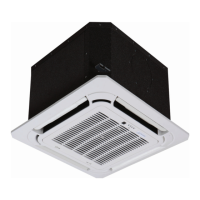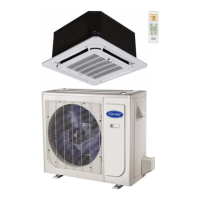
Do you have a question about the Carrier 40MHHQ24-3 and is the answer not in the manual?
| Brand | Carrier |
|---|---|
| Model | 40MHHQ24-3 |
| Category | Air Conditioner |
| Language | English |
General safety precautions for installation, servicing, and handling of equipment.
This manual provides information to service, repair, and maintain outdoor units.
Explains the meaning of each component in the model and serial number.
Provides detailed technical specifications for the heat pump unit, including electrical and refrigerant data.
Details cooling and heating performance metrics like capacity, SEER, EER, HSPF, and COP.
Lists physical dimensions, weights, and packaging specifications for different unit sizes.
Details minimum required clearances around the outdoor unit for proper airflow and service access.
Provides electrical data for power supply, compressor, and fan motor, including MCA and MOCP.
Outlines recommended methods for power and communication wiring connections for reliable operation.
Illustrates field power supply and indoor unit connection diagrams for 115V and 208-230V systems.
Presents the wiring diagram for the 12K (115V) heat pump unit, showing component connections.
Shows the wiring diagram for 9K and 18K units operating on 208-230V power supply.
Illustrates the wiring diagram for the 24K unit operating on a 208-230V power supply.
Depicts the refrigerant flow path for 12K units in both 115V and 208/230V configurations.
Illustrates the refrigerant circuit for the 9K unit operating on 208-230V power.
Details the refrigerant flow diagram for the 18K unit operating on 208-230V.
Presents the refrigerant cycle diagram for the 24K unit on a 208-230V power supply.
Guidelines for refrigerant line sizing, insulation, burial, and vibration isolation for optimal performance.
Specific guidance for line sizing and refrigerant charge adjustments for extended piping applications.
Details the deep vacuum method using a 500-micron pump and gauge to ensure system dryness.
Outlines the triple evacuation process involving nitrogen purging to remove moisture and contaminants.
Important check to ensure tubing is secure and not rubbing, preventing damage during shipment.
Defines abbreviations for temperature sensors (T1-T5) and other electronic function parameters.
Explains various protection mechanisms for the compressor, fan, inverter, and system integrity.
Describes compressor and outdoor fan running rules specifically for the cooling operational mode.
Details how indoor fan speed is controlled in cooling and auto modes, including anti-cold air function.
Explains compressor temperature protection, evaporator protection, and operating rules in HEATING mode.
Describes how the indoor fan operates automatically in heating mode, including anti-cold air function.
Details the conditions for entering DEFROST mode based on T3 temperature and compressor running time.
Explains how to manually activate forced defrosting and the conditions for exiting the defrost mode.
Explains the DRYING mode, low indoor temperature protection, and AUTO mode logic.
Details forced operation, auto-restart functionality, refrigerant leakage detection, and 46°F heating.
Instructions on how to access the unit's information enquiry status using the remote controller.
A comprehensive table listing displayed codes, their explanations, meanings, and additional notes.
Safety warning regarding discharging electricity stored in capacitors before servicing.
Table correlating operation lamp, timer lamp, display codes, and LED status for unit errors.
Diagram illustrating the component layout of the PCB for the 12K (115V) model.
Diagram showing the PCB component layout for 18K and 24K models operating on 208-230V.
Table detailing LED code combinations and their corresponding problems for unit diagnostics.
Troubleshooting steps for EEPROM parameter errors (E0/F4), including PCB replacement.
Troubleshooting guide for indoor/outdoor unit communication errors (E1), covering wiring and PCB checks.
Procedure for testing DC voltage using a multimeter on specific ports to diagnose unit issues.
Method for testing the resistance of the reactor to identify malfunctions.
Troubleshooting for zero crossing detection errors (E2), focusing on connections and PCB defects.
Steps to diagnose and resolve indoor fan speed errors (E3/F5), checking wiring, motor, and PCB.
Procedure to check DC motor voltage inputs and outputs to determine PCB or motor faults.
Troubleshooting steps for temperature sensor faults (E4/E5/F1/F2/F3), including checking connections and resistance.
Troubleshooting for refrigerant leakage detection (EC), involving sensor checks, leak repair, and recharging.
Steps to diagnose and resolve overload current protection issues (F0), checking power, blockages, and components.
Troubleshooting for IPM malfunction or over-current protection (P0), checking wiring, IPM, fan, and compressor.
Detailed procedures for measuring voltages P-U and P-V on the IPM for diagnostic purposes.
Procedures for measuring IPM voltages P-W and N-U, aiding in diagnosing drive circuit issues.
Instructions for checking IPM voltages N-V and N-W to identify potential drive system faults.
Troubleshooting for over/under voltage protection (P1), including power supply, connections, and reactor checks.
Steps to diagnose compressor top high temperature protection (P2), checking screws, airflow, and OLP.
Troubleshooting for inverter compressor drive errors (P4), covering wiring, IPM, fan, and compressor checks.
Procedure for measuring compressor winding resistance using a tester to check for faults.
Steps to perform an IPM continuity check by measuring resistance between specific terminals.
How to measure the winding resistance of the fan motor for diagnostic purposes.
Provides a chart and graph of operating pressures in cooling mode based on ODT and IDT.
Presents a chart and graph of operating pressures in heating mode based on ODT and IDT.
Instructions for removing the big handle and top cover of the outdoor unit for servicing.
Details on removing the water collecting cover and front panel for access to internal components.
Instructions for removing the right side panel to access internal parts of the outdoor unit.
Specific steps for removing the top cover and handle on the 24K model outdoor unit.
Instructions for removing the water collecting cover and front panel on the 24K unit.
Procedure for removing the right panel on the 24K model outdoor unit.
Table providing resistance values for temperature sensors T1, T2, T3, and T4 across various temperatures.
Table listing resistance values for the T5 compressor discharge temperature sensor at different temperatures.
Provides additional temperature sensor resistance data, extending the range of previous tables.












